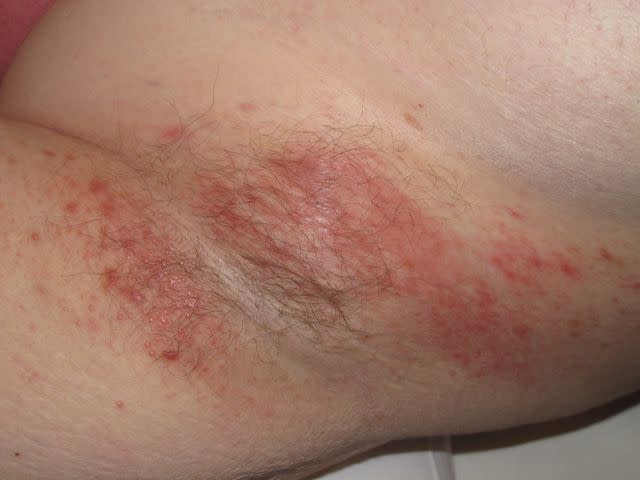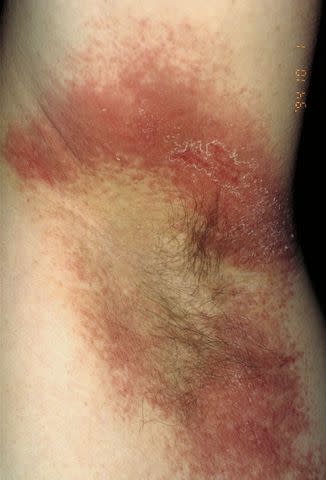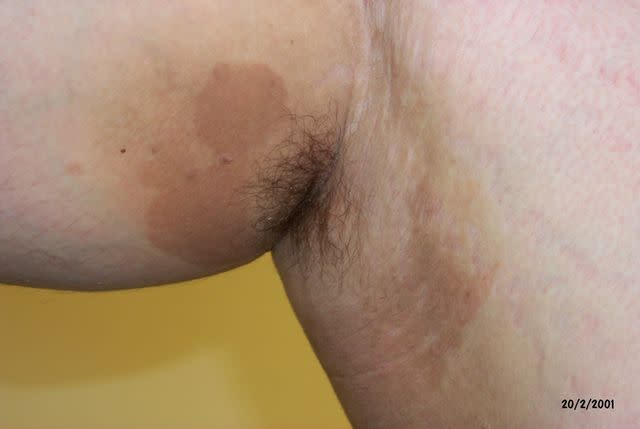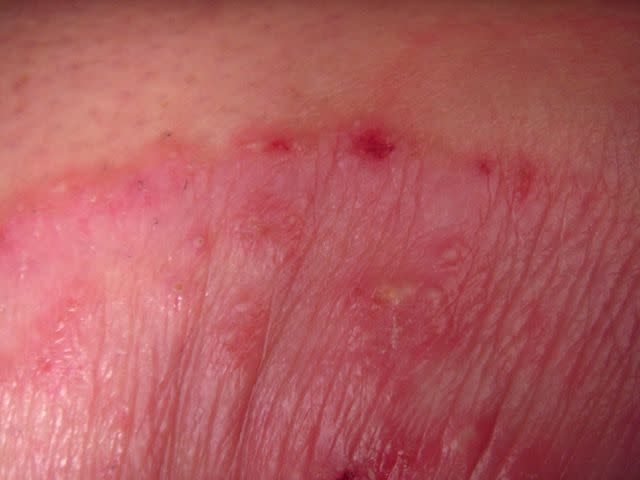Why Do I Have a Red Rash Under My Armpit?
Common Causes and Treatment Options

Westend61 / Getty Images
Medically reviewed by Casey Gallagher, MD
Armpit rashes can be caused by allergic reactions, infections, and chronic conditions. Armpits are a common place to get rashes because the skin there is thin, folds up on itself, and can be hairy. These factors create the right conditions for moisture buildup and irritation, which can lead to rashes.
This article will go over common causes of an armpit rash, and what to do if you have one.
Related: How to Identify 4 Common Skin Rashes
Allergic Contact Dermatitis

A common cause of an armpit rash is an allergic reaction. Allergic contact dermatitis occurs when an allergy-triggering substance (allergen) comes into contact with the skin. If a product like a deodorant, antiperspirant, or shaving cream gives you a rash, you might be sensitized to one or more fragrances or other ingredients.
Takeaway
Propylene glycol is a preservative and moisturizer that can also cause a rash.
Allergic contact dermatitis does not happen right away (delayed-type hypersensitivity reaction). It usually happens over time as you become hypersensitized to substances that your immune system sees as being invaders.
It can take weeks of being sensitized for a reaction, like a rash, to show up. However, when you come in contact with the trigger again, the rash will show up sooner.
The rash will often form on the area of skin that the allergen touched and make it look red, raised, and irregularly shaped. It can also cause blisters or crusting.
If you have an armpit rash from allergic contact dermatitis, figuring out what you're sensitive to and avoiding it is the first step to healing the rash and keeping it from coming back. When you're shopping for personal care products, look for ”fragrance-free" formulas to avoid common allergens.
Your provider can also prescribe treatments or recommend a product you can buy over-the-counter (OTC) to help with your symptoms.
Related: What to Do If You Have Contact Dermatitis
Irritant Contact Dermatitis
Armpit rashes can also be caused by another kind of dermatitis. Irritant contact dermatitis is similar to allergic contact dermatitis, but the reaction is not an allergy. Instead, it’s the direct effect of an irritant or toxin on the skin.
Irritant contact dermatitis in your armpit can also be caused by deodorants, antiperspirants, soaps, or body washes. The rash is red, rough, or scaly. In severe cases, it can cause blisters.
As with other kinds of dermatitis, if you have an armpit rash that's caused by an irritant, the first thing to do is to figure out what's causing your skin to react. Once you know what irritant is causing the rash, you can avoid it.
Related: Treating Dermatitis Rashes by How They Look
If your symptoms are severe or not getting better, it's important to let your provider know. In some cases, skin reactions may not clear up unless you take prescription medication (like a steroid) to help with the inflammation.
Can Eczema Cause Armpit Rashes?
Contact dermatitis is a form of a chronic inflammatory skin condition called eczema. You can get eczema rashes under your arms. The rashes can also leak fluid (weeping eczema) or look like scaly patches on your skin. In addition to atopic and contact dermatitis, there are also other kinds of eczema:
If your provider diagnoses your underarm rash as eczema, they can recommend OTC products or prescription treatments for your symptoms. Learning what your eczema triggers are and avoiding them is also helpful.
Learn More: Can You Be Allergic to Shampoo?
Folliculitis
Any part of your skin that has hair follicles can get irritated and infected, leading to a pimply rash called folliculitis. If you nick yourself shaving or have ingrown hairs in your armpit, you could get folliculitis.
If you just have a mild rash, taking a break from shaving and using any products under your arms (like deodorant) can help give it a chance to heal. If it doesn’t get better, you might need to try an OTC treatment or see your provider for a prescription (like antibiotics).
Learn More: What Is Hot Tub Folliculitis?
Intertrigo

Since your armpit skin folds on itself, it can trap moisture. Intertrigo is a rash that shows up in moist areas of skin folds. It's common in the armpits, under the breasts, and in the folds of the groin and abdomen.
The rash is often caused by yeast, fungi, or bacteria that love being in a damp environment. These germs trigger your immune system to react, which leads to skin inflammation and rash.
The symptoms of intertrigo include:
Roughly symmetrical red or reddish-brown rash with small bumps
Itching
Stinging or burning pain
Cracks and bleeding (if left untreated)
Foul smell and pus-containing bumps (if infected)
Treatment for intertrigo starts by reducing inflammation and other symptoms, which can often be done with OTC products. You may also need antibiotics or antifungals to fight the organisms that caused the rash.
You can prevent intertrigo by keeping your skin clean and dry, and avoiding wearing tight-fitting clothing that doesn't give your skin a chance to "breathe."
Yeast Infections
Since yeast likes to live in warm, wet places, the space under your arm is a common place to get a yeast infection (candidiasis).
You can also get a yeast infection after you’ve had intertrigo—and the same treatments (antifungals) will usually clear it up.
Related: Why You Get Intertrigo in Skin Folds
Erythrasma

An armpit rash can also be caused by a specific germ. Erythrasma is a rash that can form after you’ve had an infection with the Corynebacterium minutissimum bacteria.
Erythrasma is common in the armpits, under the breasts, in groin folds, and between the toes. The rash is reddish and/or tan and looks coral-red under a black light. The rash can cause slight skin wrinkling.
Erythrasma can be mildly itchy but usually does not have any other symptoms.
If you get erythrasma in your armpit, you'll probably need to be treated with antibiotics like erythromycin.
Related: How Erythrasma is Linked to Humidity and Diabetes
Ringworm

Some common skin infections may show up as an armpit rash. Tinea corporis is commonly called “ringworm," but it's actually a skin infection that's caused by a fungus, not a worm.
There are different types of fungi that can cause ringworm and the name of the infection changes depending on where it is.
For example, when it's in the underarm or behind the knee, it's called tinea corporis. If it's on the foot, it's called tinea pedis (or "athlete's foot"). When it shows up in the groin, it's called tinea cruris (or "jock itch").
The rash from ringworm usually looks red and has raised borders which can have a thin layer of scales on them. The key feature of a ringworm rash is that it grows outward in a circle. Ringworm can also be itchy and makes the hair on the affected area of the skin fall out.
Ringworm is treated with topical antifungal medications, many of which you can get OTC at the pharmacy.
Related: 6 Causes of a Circular Rash
Acanthosis Nigricans
Armpit rashes can also happen from causes that are not linked to an infection. Acanthosis nigricans is a condition that can make the skin have dark, “velvety,” raised patches. It appears in the skin folds of the armpits, groin, and around the neck. It's not common, but an acanthosis nigricans rash can be itchy.
Acanthosis nigricans is linked to increased insulin levels in your blood. This can happen with conditions like:
Obesity
Diabetes or insulin resistance
Hormonal changes
Certain medications
Acanthosis nigricans is not treated directly. Instead, the condition that's causing it needs to be treated. Once the underlying condition is under control, the rash should get better.
Learn More: Treating Acanthosis Nigricans
Inverse Psoriasis
Another cause of an armpit rash that’s not an infection is psoriasis, a chronic autoimmune condition. One form of psoriasis is especially likely to show up on skin folds, including under your arm.
Inverse psoriasis is seen in places where skin rubs together (intertriginous), including near the genitals. In addition to being in the armpit, you may have a rash in other parts of your body that bend (flexural) like behind your knees and elbows.
Unlike plaque psoriasis, the red rash from inverse psoriasis is usually smooth and shiny and doesn’t have scales. It may look brown or tan on darker skin tones.
If you go to your provider for a skin rash in your armpit, they might be able to diagnose it as psoriasis just by looking at it. They can also take a scraping of the skin to look at with a microscope (biopsy).
The treatment for inverse psoriasis is a combination of lifestyle changes, over-the-counter (OTC) remedies, and prescription medications.
Since inverse psoriasis tends to be on sensitive parts of your body, your provider will discuss which psoriasis treatments will be the best option for you. Some of the standard psoriasis therapies can be too harsh for a rash on thin, fragile skin.
Learn More: Psoriasis Photos
Hidradenitis Suppurativa/Acne Inversa
Another chronic health condition that can cause a rash in your armpit is hidradenitis suppurativa, also called acne inversa.
In this condition, hair follicles near sweat glands get blocked up and cause skin irritation. The rash that forms is made of painful bumps that have pus in them (which you may smell if they break open). Over time, breakouts of the rash can lead to scarred skin.
If your provider diagnoses you with hidradenitis suppurativa, they may want you to start using OTC topical treatments to see if they help you manage it. If the condition is more severe, you may need prescription medications.
If you get really big bumps that are very painful and won’t heal, your provider may need to open them up so they can drain.
Learn More: What to Eat When You Have Hidradenitis Suppurativa
Heat Rash
You can actually get heat rash in your armpits, though it’s not as common as getting it on more exposed parts of your body.
You can get heat rash under your arms for a lot of the same reasons that you can get infections and irritation, especially blocked sweat glands.
A “prickly heat” rash in your armpits can be uncomfortable but usually isn’t serious. It should clear up on its own, and it’ll help if you keep the skin dry. If the rash is severe, your provider might recommend you try using a lotion that can calm inflammation.
Can You Get Cancer In Your Armpit?
Cancer is not a common cause of armpit rashes, but itchy, irritated skin can be a sign of some types of cancer including Hodgkin lymphoma, skin lymphoma, or breast cancer. It is also common for cancer treatment like chemotherapy or radiation to cause a rash, which can sometimes affect the armpit.
Syphilis
Syphilis is a sexually transmitted bacterial illness. The condition can cause a range of symptoms that can make it difficult to distinguish from other illnesses. Skin rashes may appear during the secondary stage of syphilis, along with other symptoms like fever, swollen lymph nodes, and headache.
A syphilis rash may appear on many different parts of the body. It doesn't always look the same on everyone. The rash is most likely to develop in the armpits and other warm, moist parts of the body tend to be large, raised, and gray or white. These rashes are not itchy or painful, so you might not notice them.
If you have symptoms of syphilis or suspect you may have had sexual contact with someone who has the disease, it is important to be evaluated by a healthcare provider right away.
Preventing Armpit Rashes
Most armpit rashes can be prevented with self-care strategies. Some of the things you can do include the following:
Look for skincare products and laundry detergent that is non-irritating.
Wear loose, breathable fabrics such as cotton.
Shower regularly and dry your underarms completely.
If you are overweight, weight loss can reduce chafing in your underarms and other parts of your body.
Make sure any skin conditions you have are well-managed.
Avoid spending long periods in hot environments.
Try an anti-chafing powder.
If you aren't sure what's causing your rash, if these remedies don't seem to help, or if your rash gets worse, see a healthcare provider.
Related: When to Worry About a Skin Rash
Summary
The armpits are common places for rashes because the skin there is thin and damp. Some armpit rashes are from skin irritation and allergic reactions, while others are caused by infections or chronic health conditions that need to be treated.
You may not be able to figure out what’s causing an armpit rash on your own. While a mild armpit rash can probably be taken care of a home, see a provider if it’s not getting better. They can make a diagnosis and talk to you about treatment.
Related: Rashes from A to Z
Read the original article on Verywell Health.

